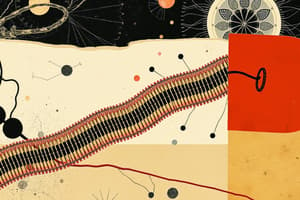Podcast
Questions and Answers
What is the main difference between a theory and a hypothesis?
What is the main difference between a theory and a hypothesis?
- A theory is a guess, while a hypothesis is a tested idea
- A hypothesis cannot be tested, while a theory can
- A hypothesis is broader and more comprehensive than a theory
- A theory is a well-tested and widely accepted explanation, while a hypothesis is a testable prediction (correct)
What are the three main subatomic particles of an atom?
What are the three main subatomic particles of an atom?
- Neutrons, neutrinos, electrons
- Protons, neutrons, electrons (correct)
- Protons, neutrons, photons
- Protons, quarks, electrons
What happens when the number of protons in an atom changes?
What happens when the number of protons in an atom changes?
- The atom changes to a different element (correct)
- The atom becomes an ion
- The atom becomes radioactive
- The atom becomes an isotope
What happens when the number of neutrons in an atom changes?
What happens when the number of neutrons in an atom changes?
What does the atomic number of an element represent?
What does the atomic number of an element represent?
What is the basis for ionic interactions?
What is the basis for ionic interactions?
What is the basis for covalent interactions?
What is the basis for covalent interactions?
Which of the following is an example of an ionic bond?
Which of the following is an example of an ionic bond?
What is a characteristic that is NOT shared by all living organisms?
What is a characteristic that is NOT shared by all living organisms?
What is the primary function of homeostasis?
What is the primary function of homeostasis?
Which of the following is a characteristic of prokaryotes?
Which of the following is a characteristic of prokaryotes?
What is a common feature of both prokaryotes and eukaryotes?
What is a common feature of both prokaryotes and eukaryotes?
What is the first step in the scientific method?
What is the first step in the scientific method?
What follows after forming a hypothesis in the scientific method?
What follows after forming a hypothesis in the scientific method?
What is a distinguishing feature of viruses?
What is a distinguishing feature of viruses?
What is a hypothesis?
What is a hypothesis?
Flashcards are hidden until you start studying
Study Notes
Attributes of Living Organisms
- Growth and development, response to stimuli, and metabolism are attributes of living organisms.
- Reproduction is also an attribute of living organisms, which means that the inability to reproduce is not an attribute.
Homeostasis
- Homeostasis is the ability to maintain a stable internal environment.
Prokaryotes and Eukaryotes
Prokaryotes
- Prokaryotes are a type of cell, and E. coli is an example of a prokaryote.
- Prokaryotes do not have a nucleus.
Eukaryotes
- Eukaryotes are a type of cell, and humans, oak trees, and mushrooms are examples of eukaryotes.
- Eukaryotes have a nucleus and mitochondria.
- Both prokaryotes and eukaryotes have ribosomes.
Evolutionary Timeline
- Prokaryotes first appeared approximately 3.5 billion years ago in the evolutionary timeline.
Viruses
- Viruses lack cellular structure, which sets them apart from prokaryotes and eukaryotes.
Scientific Method
Steps
- The steps of the scientific method are: making an observation, forming a hypothesis, conducting an experiment, and drawing a conclusion.
Hypothesis versus Theory
Hypothesis
- A hypothesis is a tentative explanation that can be tested by experiments or observations.
Theory
- A theory is a well-tested and widely accepted explanation of some aspect of the natural world.
- A theory differs from a hypothesis in that it is more comprehensive and widely accepted.
Atomic Structure
Subatomic Particles
- The three main subatomic particles of an atom are protons, neutrons, and electrons.
Atomic Number
- The atomic number of an element represents the number of protons in the nucleus.
Atomic Mass
- The atomic mass of an element represents the average mass of all isotopes of the element.
Isotopes
- If the number of neutrons in an atom changes, the atom becomes an isotope.
Ions
- If the number of electrons in an atom changes, the atom becomes an ion.
Molecules and Types of Bonds
Ionic Interactions
- Ionic interactions are based on the attraction between oppositely charged ions.
- NaCl is an example of an ionic bond.
Covalent Interactions
- Covalent interactions are based on the sharing of electrons.
- The two main types of covalent bonds are polar and nonpolar.
Studying That Suits You
Use AI to generate personalized quizzes and flashcards to suit your learning preferences.




